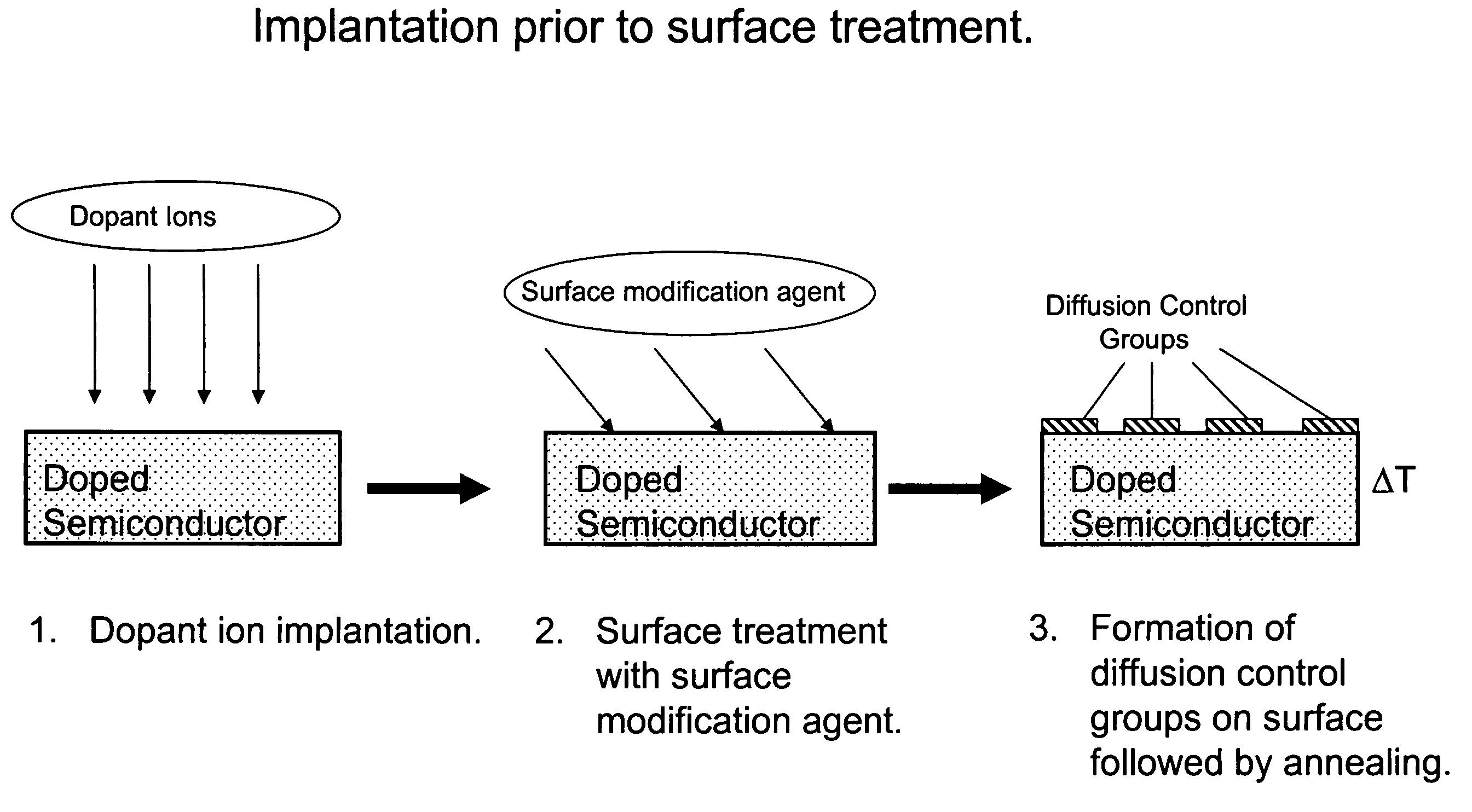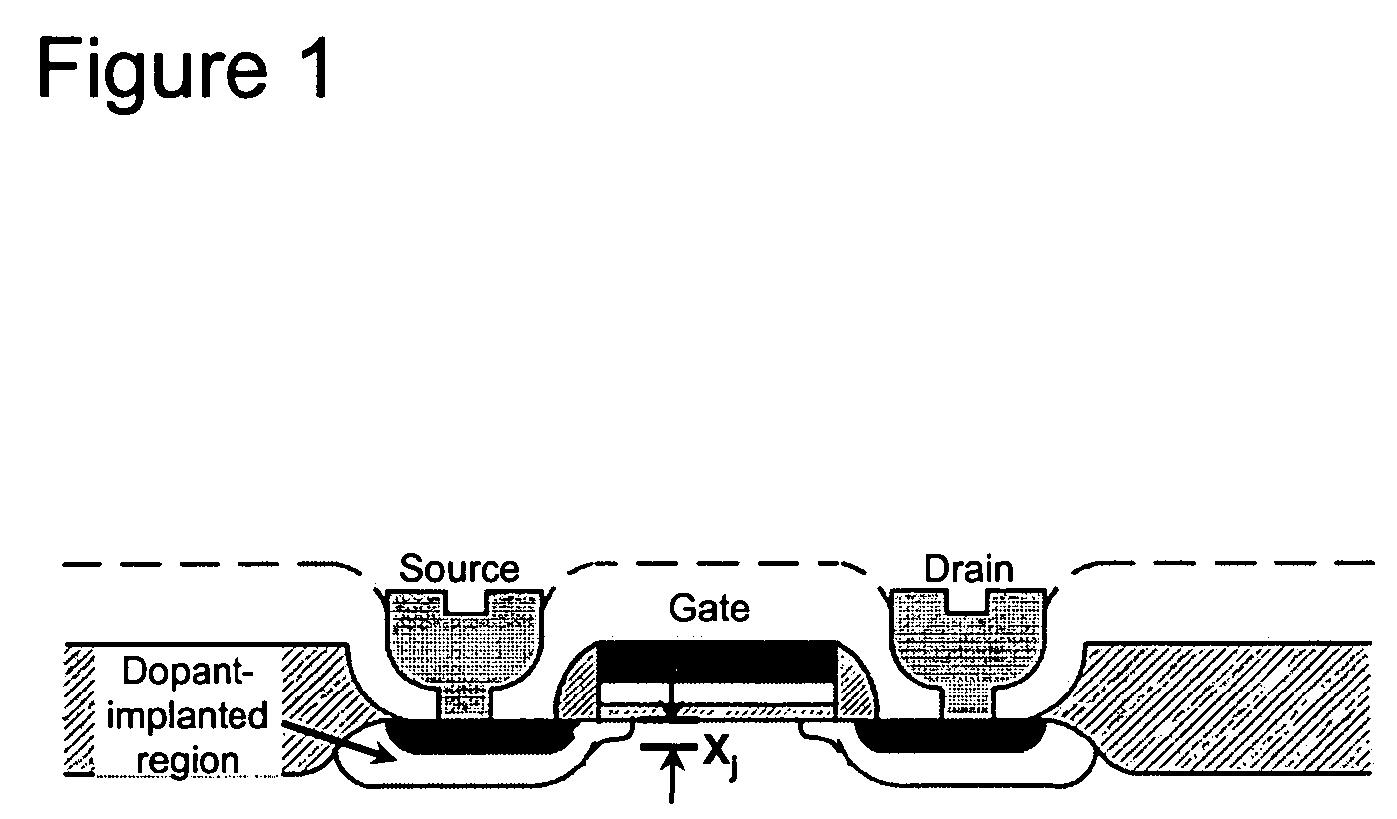Methods for controlling dopant concentration and activation in semiconductor structures
a technology of dopant concentration and activation, which is applied in the direction of semiconductor devices, electrical equipment, basic electric elements, etc., can solve the problems of increasing physical dimensions, affecting the feature size and spacing requirements of electrical components in dense integrated electrical circuits, and not having known manufacturing solutions to meet the requirements of rapidly evolving devices
- Summary
- Abstract
- Description
- Claims
- Application Information
AI Technical Summary
Benefits of technology
Problems solved by technology
Method used
Image
Examples
example 1
Numerical Simulations and Experimental Observations of Dopant Diffusion and Activation Control Provided by Selective Variation of Surface Loss Probability for Interstitial
[0085]The ability of the present methods to control dopant diffusion and electrical activation was verified by numerical simulations. Specifically, it is a goal of the present invention to provide methods of making doped semiconductor structures having a selected dopant concentration depth profile. Further, it is a goal of the present invention to provide methods of making ultra-shallow doped semiconductor structures that exhibit low dopant loss and having low electrical resistance.
1. Computational Approach:
[0086]To model bulk-surface coupling in semiconductor dopant diffusion, we have developed a computational model for diffusion and dopant activation, primarily for simulating boron implanted in silicon, by adapting the simulator FLOOPS 2000 (by Mark E. Law of the University of Florida and Al Tasch of the Universi...
example 2
The Use of Nitrogen Release Gases as Surface Modification Agents in the Methods of the Present Invention
[0107]Gases that release nitrogen to semiconductor surfaces, such as ammonia or hydrazine, comprise particularly useful surface modification agents in the methods of the present invention. Exposure of a semiconductor surface to surface modifying groups that release nitrogen, under some conditions, forms nitride (Si3N4) on the treated surface. This mechanism of surface treatment avoids two major problems that plague surface manipulation using surface modification agents comprising oxygen. First, silicon-nitrogen compounds do not readily volatilize from the Si surface. Second, nitride growth injects vacancies instead of interstitials into the underlying Si. The lack of volatilization removes an important constraint in controlling surface-bulk coupling, since in principle no nitrogen-containing gas would need to be added during heating for nitride replenishment. And if such a gas wer...
example 3
Controlling Defect Concentrations in Bulk Semiconductor Materials Via Surface Adsorption
[0110]In addition to providing a means of controlling diffusion and activation of dopants implanted in semiconductor materials, the methods of the present invention also provide a means of controlling the concentrations and concentration depth profiles of defects in bulk semiconductors. Specific modification of the surfaces of undersaturated semiconductor materials, such as heated unimplanted semiconductors, by treatment with surface modifying agents provides a means of selectively controlling the concentrations and concentration depth profiles of vacancies and interstitials in bulk semiconductors. In such undersaturated semiconductor materials, dangling, free bonds at the surface act as sources of defects by releasing interstitials into the bulk under some conditions. The strength of this source of interstitials is selectable in the present invention by modifying the composition of the surface, ...
PUM
 Login to View More
Login to View More Abstract
Description
Claims
Application Information
 Login to View More
Login to View More - R&D
- Intellectual Property
- Life Sciences
- Materials
- Tech Scout
- Unparalleled Data Quality
- Higher Quality Content
- 60% Fewer Hallucinations
Browse by: Latest US Patents, China's latest patents, Technical Efficacy Thesaurus, Application Domain, Technology Topic, Popular Technical Reports.
© 2025 PatSnap. All rights reserved.Legal|Privacy policy|Modern Slavery Act Transparency Statement|Sitemap|About US| Contact US: help@patsnap.com



